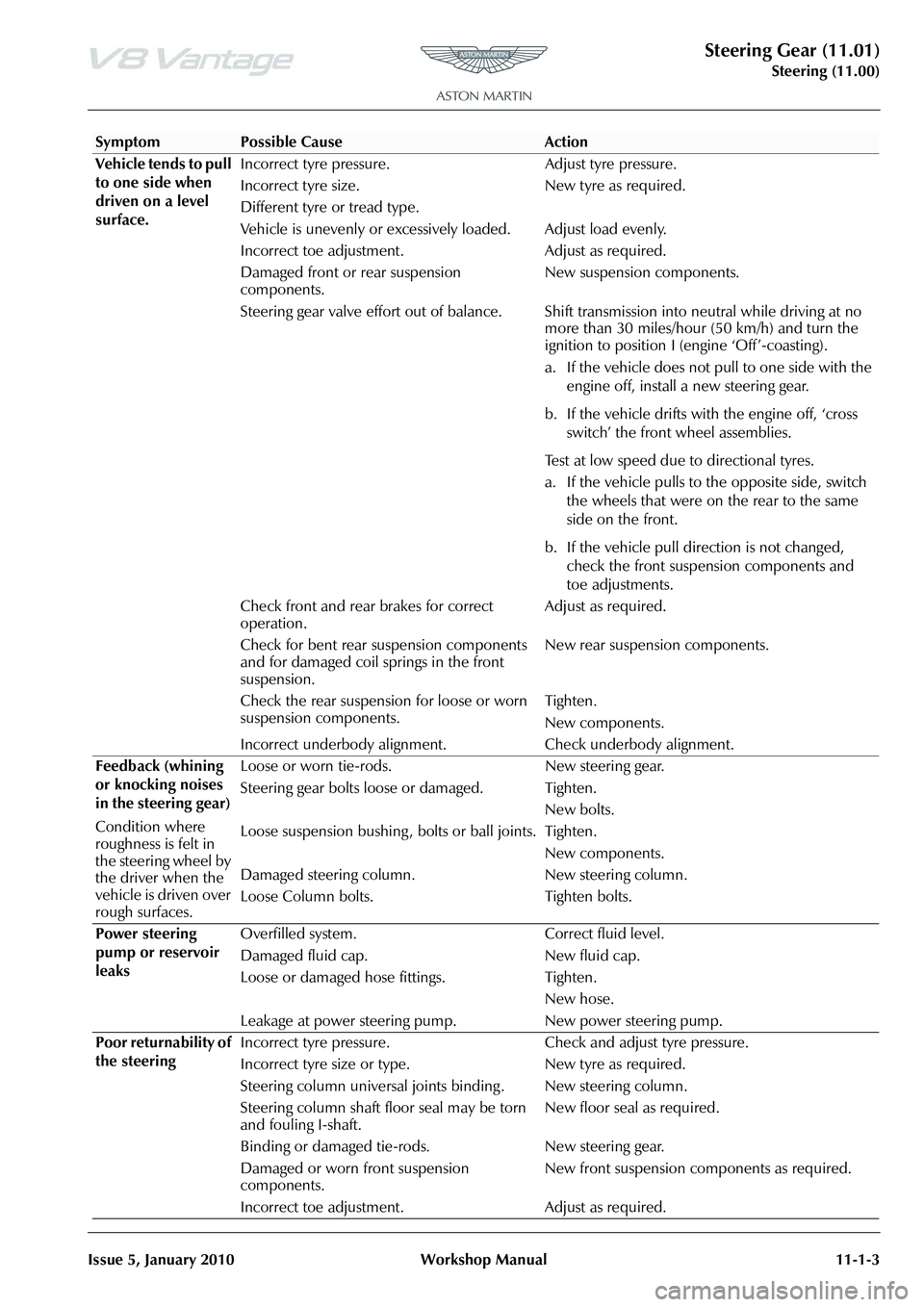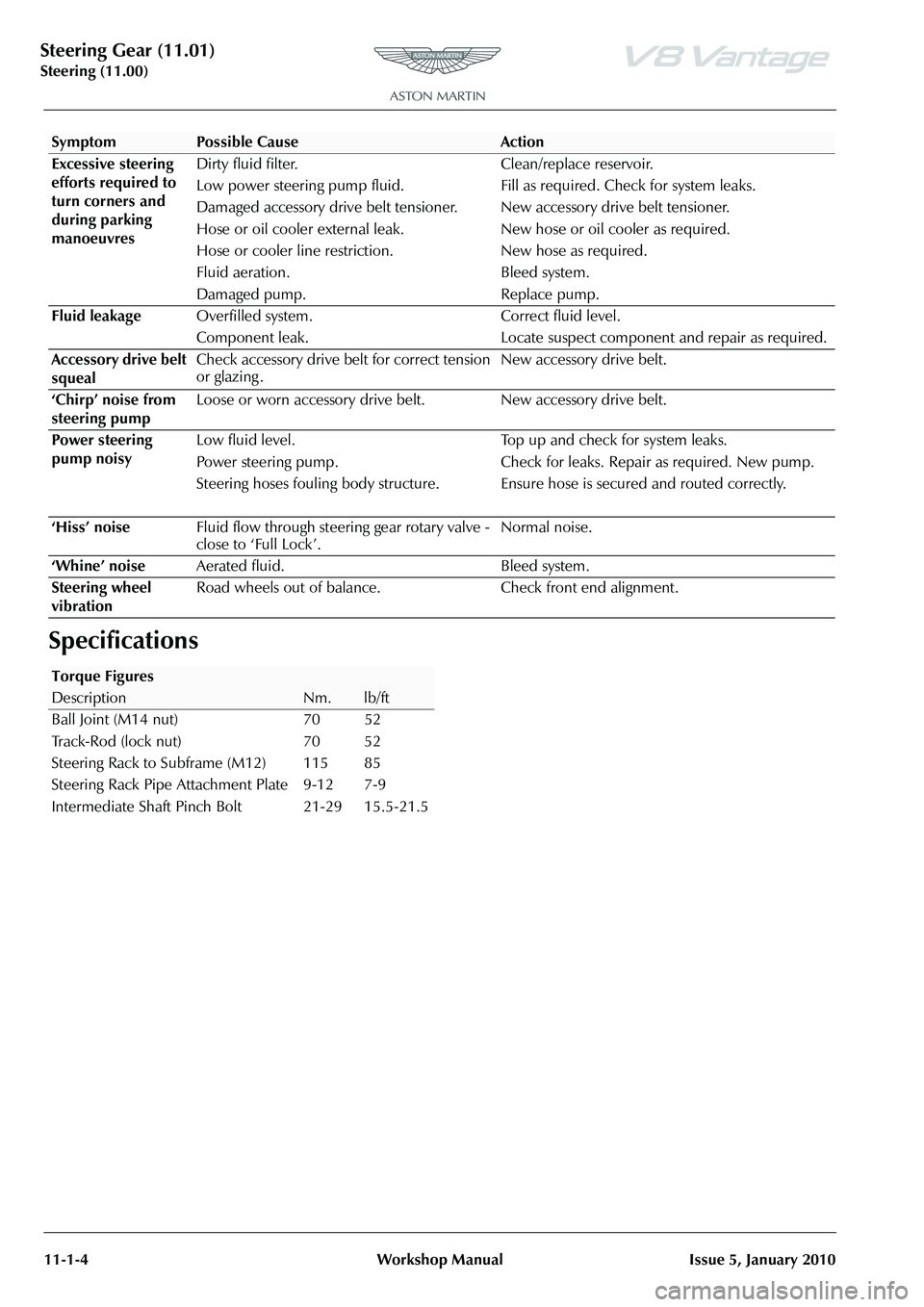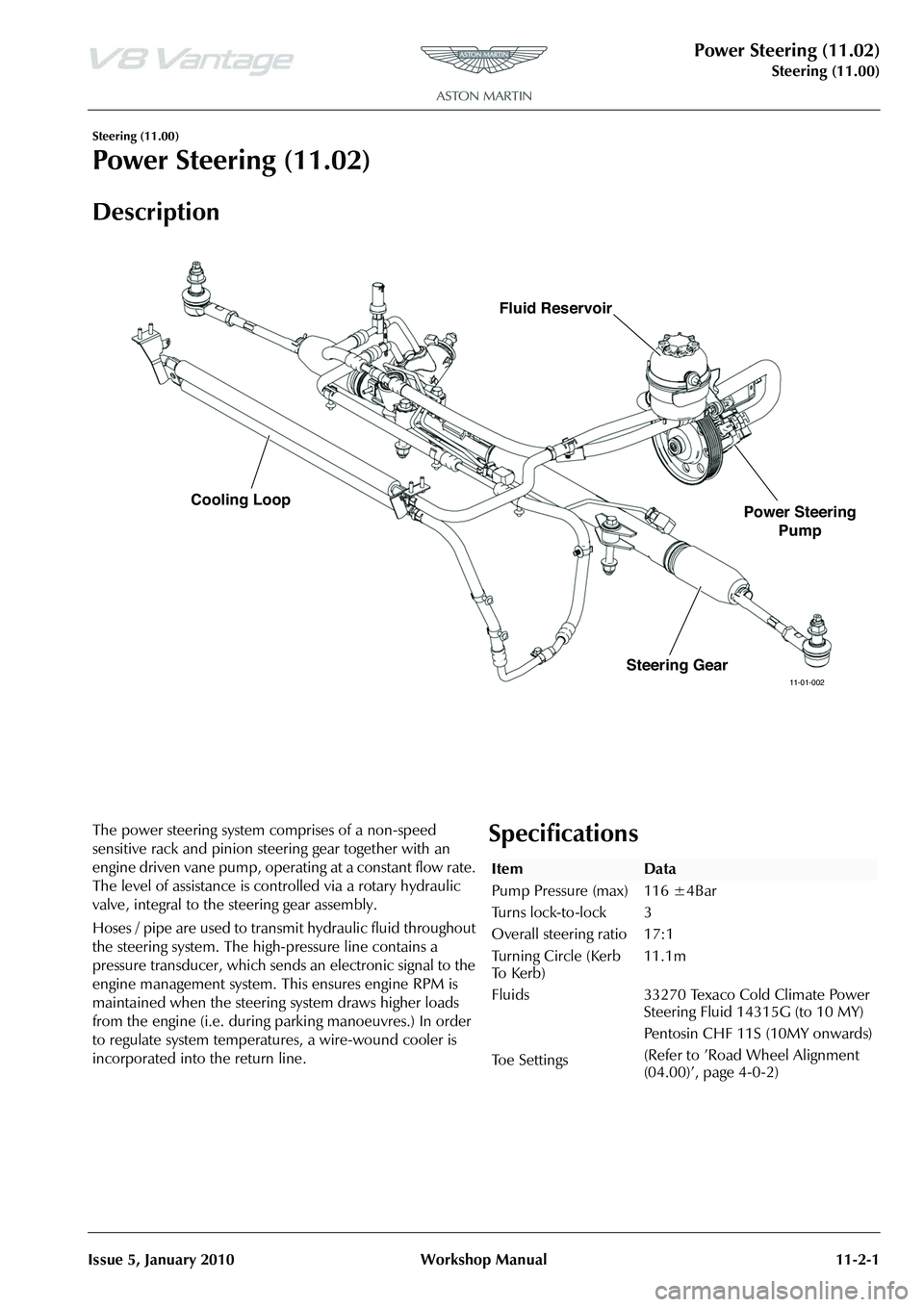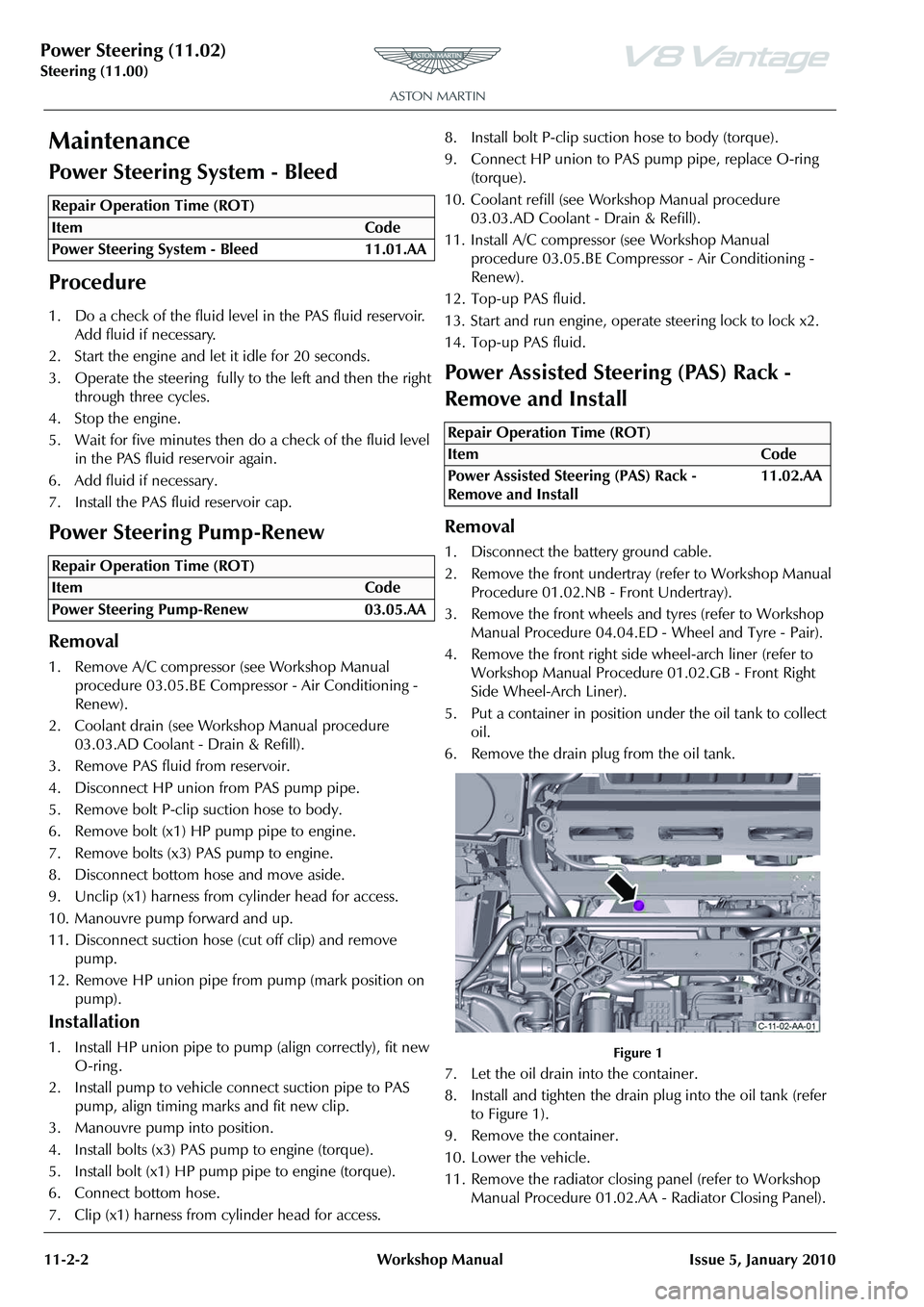steering ASTON MARTIN V8 VANTAGE 2010 Service Manual
[x] Cancel search | Manufacturer: ASTON MARTIN, Model Year: 2010, Model line: V8 VANTAGE, Model: ASTON MARTIN V8 VANTAGE 2010Pages: 947, PDF Size: 43.21 MB
Page 601 of 947

Steering Gear (11.01)
Steering (11.00)11-1-2 Workshop Manual Issue 5, January 2010
Steering (11.00)
Steering Gear (11.01)
Diagnostics - Symptom Chart
11-01-001
Upper Cowl Lower Cowl
Steering Column
Steering Angle Sensor
Bulkhead Seal
Intermediate Shaft
Pressure Transducer Pinion Extension Shaft
Cooling Loop Switch Gear Assy
Fluid Reservoir
Steering Gear Track Rod Ends
SymptomPossible CauseAction
Vehicle wanders
from side to side on
the road when
driven straight
ahead with the
steering wheel held
firmly. Incorrect tyre size or pressure. Check for correct tyre size.
Adjust tyre pressures.
Vehicle unevenly loaded or overloaded. Adjust load.
Loose or worn tie-rods or tie-rod ends. New tie-rod end or steering gear.
Steering gear bolts loose or damaged. Tighten. New bolts.
Loose or worn suspension ball joint(s). New suspension ball joint assembly.
Steering column universal joint pinch bolt
loose. Tighten pinch bolt.
Incorrect toe adjustment. Adjust as required.
Loose or worn rear suspension. Tighten if loose. New rear suspension components.
Insufficient Castor. Check fr ont suspension geometry.
Page 602 of 947

Steering Gear (11.01)
Steering (11.00)
Issue 5, January 2010 Workshop Manual 11-1-3
Vehicle tends to pull
to one side when
driven on a level
surface. Incorrect tyre pressure. Adjust tyre pressure.
Incorrect tyre size.
Different tyre or tread type.
New tyre as required.
Vehicle is unevenly or excessively loaded. Adjust load evenly.
Incorrect toe adjustment. Adjust as required.
Damaged front or rear suspension
components. New suspension components.
Steering gear valve effort out of balance. Shift transmission into neutral while driving at no more than 30 miles/hour (50 km/h) and turn the
ignition to position I (engine ‘Off’-coasting).
a. If the vehicle does not pull to one side with the
engine off, install a new steering gear.
b. If the vehicle drifts with the engine off, ‘cross switch’ the front wheel assemblies.
Test at low speed due to directional tyres.
a. If the vehicle pulls to the opposite side, switch the wheels that were on the rear to the same
side on the front.
b. If the vehicle pull direction is not changed, check the front suspension components and
toe adjustments.
Check front and rear brakes for correct
operation. Adjust as required.
Check for bent rear suspension components
and for damaged coil springs in the front
suspension. New rear suspension components.
Check the rear suspension for loose or worn
suspension components. Tighten.
New components.
Incorrect underbody alignment. Check underbody alignment.
Feedback (whining
or knocking noises
in the steering gear)
Condition where
roughness is felt in
the steering wheel by
the driver when the
vehicle is driven over
rough surfaces. Loose or worn tie-rods. New steering gear.
Steering gear bolts loose or damaged. Tighten.
New bolts.
Loose suspension bushing , bolts or ball joints. Tighten.
New components.
Damaged steering column.
Loose Column bolts. New steering column.
Tighten bolts.
Power steering
pump or reservoir
leaks Overfilled system. Correct fluid level.
Damaged fluid cap. New fluid cap.
Loose or damaged hose fittings. Tighten.
New hose.
Leakage at power steering pump. New power steering pump.
Poor returnability of
the steering Incorrect tyre pressure. Check
and adjust tyre pressure.
Incorrect tyre size or ty pe. New tyre as required.
Steering column universal joints binding . New steering column.
Steering column shaft floor seal may be torn
and fouling I-shaft. New floor seal as required.
Binding or damaged tie-rods. New steering gear.
Damaged or worn front suspension
components. New front suspension components as required.
Incorrect toe adjustment. Adjust as required.
SymptomPossible CauseAction
Page 603 of 947

Steering Gear (11.01)
Steering (11.00)11-1-4 Workshop Manual Issue 5, January 2010
Specifications
Excessive steering
efforts required to
turn corners and
during parking
manoeuvres Dirty fluid filter.
Low power steering pump fluid.
Clean/replace reservoir.
Fill as required. Check for system leaks.
Damaged accessory drive belt tensioner. New accessory drive belt tensioner.
Hose or oil cooler external leak. New hose or oil cooler as required.
Hose or cooler line restriction. New hose as required.
Fluid aeration.
Damaged pump. Bleed system.
Replace pump.
Fluid leakage Overfilled system. Correct fluid level.
Component leak. Locate suspect component and repair as required.
Accessory drive belt
squeal Check accessory drive belt for correct tension
or glazing .
New accessory drive belt.
‘Chirp’ noise from
steering pump Loose or worn accessory drive belt. New accessory drive belt.
Power steering
pump noisy Low fluid level. Top up and check for system leaks.
Power steering pump.
Steering hoses fouling body structure. Check for leaks. Repair
as required. New pump.
Ensure hose is secured and routed correctly.
‘Hiss’ noise Fluid flow through steering gear rotary valve -
close to ‘Full Lock’. Normal noise.
‘Whine’ noise Aerated fluid. Bleed system.
Steering wheel
vibration Road wheels out of balance. Check front end alignment.
SymptomPossible CauseAction
Torque Figures
DescriptionNm.lb/ft
Ball Joint (M14 nut) 70 52
Track-Rod (lock nut) 70 52
Steering Rack to Subframe (M12) 115 85
Steering Rack Pipe Attachment Plate 9-12 7-9
Intermediate Shaft Pinch Bolt 21-29 15.5-21.5
Page 604 of 947

Power Steering (11.02)
Steering (11.00)
Issue 5, January 2010 Workshop Manual 11-2-1
Steering (11.00)
Power Steering (11.02)
Description
The power steering system comprises of a non-speed
sensitive rack and pinion steering gear together with an
engine driven vane pump, operating at a constant flow rate.
The level of assistance is co ntrolled via a rotary hydraulic
valve, integral to the steering gear assembly.
Hoses / pipe are used to transm it hydraulic fluid throughout
the steering system. The high -pressure line contains a
pressure transducer, which sends an electronic signal to the
engine management system. This ensures engine RPM is
maintained when the steering system draws higher loads
from the engine (i.e. during parking manoeuvres.) In order
to regulate system temperatures, a wire-wound cooler is
incorporated into the return line.Specifications
11-01-002Steering Gear
Cooling Loop
Power Steering
Pump
Fluid Reservoir
ItemData
Pump Pressure (max)
Turns lock-to-lock
Overall steering ratio
Turning Circle (Kerb
To K e r b )
Fluids
Toe Settings 116 ±4Bar
3
17:1
11.1m
33270 Texaco Cold Climate Power
Steering Fluid 14315G (to 10 MY)
Pentosin CHF 11S (10MY onwards)
(Refer to ’Road Wheel Alignment
(04.00)
Page 605 of 947

Power Steering (11.02)
Steering (11.00)11-2-2 Workshop Manual Issue 5, January 2010
Maintenance
Power Steering System - Bleed
Procedure
1. Do a check of the fluid level in the PAS fluid reservoir. Add fluid if necessary.
2. Start the engine and let it idle for 20 seconds.
3. Operate the steering fully to the left and then the right through three cycles.
4. Stop the engine.
5. Wait for five minutes then do a check of the fluid level in the PAS fluid reservoir again.
6. Add fluid if necessary.
7. Install the PAS fluid reservoir cap.
Power Steering Pump-Renew
Removal
1. Remove A/C compressor (see Workshop Manual procedure 03.05.BE Compre ssor - Air Conditioning -
Renew).
2. Coolant drain (see Workshop Manual procedure 03.03.AD Coolant - Drain & Refill).
3. Remove PAS fluid from reservoir.
4. Disconnect HP union from PAS pump pipe.
5. Remove bolt P-clip suction hose to body.
6. Remove bolt (x1) HP pump pipe to engine.
7. Remove bolts (x3) PAS pump to engine.
8. Disconnect bottom hose and move aside.
9. Unclip (x1) harness from cylinder head for access.
10. Manouvre pump forward and up.
11. Disconnect suction hose (cut off clip) and remove pump.
12. Remove HP union pipe from pump (mark position on
pump).
Installation
1. Install HP union pipe to pump (align correctly), fit new O-ring.
2. Install pump to vehicle connect suction pipe to PAS pump, align timing marks and fit new clip.
3. Manouvre pump into position.
4. Install bolts (x3) PAS pump to engine (torque).
5. Install bolt (x1) HP pump pipe to engine (torque).
6. Connect bottom hose.
7. Clip (x1) harness from cylinder head for access. 8. Install bolt P-clip suction hose to body (torque).
9. Connect HP union to PAS pump pipe, replace O-ring
(torque).
10. Coolant refill (see Workshop Manual procedure 03.03.AD Coolant - Drain & Refill).
11. Install A/C compressor (see Workshop Manual procedure 03.05.BE Compre ssor - Air Conditioning -
Renew).
12. Top-up PAS fluid.
13. Start and run engine, operate steering lock to lock x2.
14. Top-up PAS fluid.
Power Assisted Steering (PAS) Rack -
Remove and Install
Removal
1. Disconnect the battery ground cable.
2. Remove the front undertray (refer to Workshop Manual Procedure 01.02.NB - Front Undertray).
3. Remove the front wheels and tyres (refer to Workshop Manual Procedure 04.04.ED - Wheel and Tyre - Pair).
4. Remove the front right side wheel-arch liner (refer to Workshop Manual Procedure 01.02.GB - Front Right
Side Wheel-Arch Liner).
5. Put a container in position under the oil tank to collect oil.
6. Remove the drain plug from the oil tank.
Figure 1
7. Let the oil drain into the container.
8. Install and tighten the drain plug into the oil tank (refer to Figure 1).
9. Remove the container.
10. Lower the vehicle.
11. Remove the radiator closing panel (refer to Workshop Manual Procedure 01.02.AA - Radiator Closing Panel).
Repair Operation Time (ROT)
Repair Operation Time (ROT)
Repair Operation Time (ROT)
ItemCode
Power Assisted Steering (PAS) Rack -
Remove and Install 11.02.AA
Page 606 of 947

Power Steering (11.02)
Steering (11.00)
Issue 5, January 2010 Workshop Manual 11-2-3
12. Disconnect the two breather pipes from the air intake pipe.
Figure 2
13. Install sealing caps into the open ports.
14. Release the clip that attaches the air intake pipe to the throttle body.
Figure 3
15. Release the clip that attaches the air intake pipe to the outlet pipe for the right side air cleaner.
Figure 4
16. Disconnect the air intake pi pe from the outlet pipe for
the right side air cleaner and move it away.
Figure 5
17. Disconnect the two oil breather pipes from the oil tank.
Figure 6
18. Install sealing caps into the open ports.
19. Loosen the union that attaches the top oil pipe to the oil tank and move the pipe away.
Figure 7
20. Install sealing plugs into the open ports.
Page 607 of 947

Power Steering (11.02)
Steering (11.00)11-2-4 Workshop Manual Issue 5, January 2010
21. Remove the two top screws that attach the oil tank to the body.
Figure 8
22. Lift the vehicle.
23. Remove the four screws that attach the anti-roll bar to the front subframe.
Figure 9
24. Move the anti-roll bar away and use a cable tie to hold it.
25. Loosen the union that attaches the bottom oil pipe to the oil tank and move the pipe away.
Figure 10
26. Disconnect the two lower oil pipes from the oil tank and move them away.
27. Install sealing caps in the open ports. 28. Remove the two bottom screws that attach the oil tank
to the body.
Figure 11
29. Lower the vehicle.
30. Carefully remove the oil tank.
Figure 12
31. Lift the vehicle.
32. Remove the bolt that attaches the universal joint for the lower steering column to the pinion coupling.
Figure 13
CAUTION
Be careful when you remove the oil tank in the step that follows. If you are not, the air conditioning switch and
wiring harness can be damaged.
Page 608 of 947

Power Steering (11.02)
Steering (11.00)
Issue 5, January 2010 Workshop Manual 11-2-5
33. Turn the lever on the universal joint to release it from the coupling.
Figure 14
34. Move the steering to get access to the bolt that attaches the pinion coupling to the Po wer Assisted Steering (PAS)
rack.
35. Remove the bolt that attaches the pinion coupling to the PAS rack.
Figure 15
36. Remove the pinion coupling.
37. Remove and discard the two bolts that attach the brake caliper to the front wheel knuckle.
Figure 16
38. Release the brake caliper from the front wheel knuckle.
Figure 17
39. Use a cable tie to hold the brake caliper.
40. Make a mark to show the position of the brake disc
against the wheel hub.
41. Remove the two screws that attach the brake disc to the wheel hub.
Figure 18
42. Remove the brake disc.
CAUTION
Do not let the caliper hang on the brake hose. If you do, the brake hose can be damaged
Page 609 of 947

Power Steering (11.02)
Steering (11.00)11-2-6 Workshop Manual Issue 5, January 2010
43. Remove the front bolt that attaches the brake backplate to the front wheel knuckle.
Figure 19
44. Remove and discard the nut that attaches the track rod
end to the front wheel knuckle.
Figure 20
45. Use the special tool to release the track rod end from the vertical link.
Figure 21
46. Remove the special tool from the track rod end.
47. Do steps 39 to 48 for the other side.
48. Put a container in position under the PAS rack to collect spilled oil.
49. Lower the vehicle. 50. Remove the bolt that attaches the PAS pipes to the PAS
rack.
Figure 22
51. Disconnect the PAS pipes from the PAS rack.
Figure 23
52. Let the oil drain into the container.
53. Lift the vehicle.
54. Remove and discard the two O-ring seals from the PAS pipes.
Figure 24
55. Install applicable caps to seal the open ports.
56. Make sure that the area is clean.
Page 610 of 947

Power Steering (11.02)
Steering (11.00)
Issue 5, January 2010 Workshop Manual 11-2-7
57. Remove the three bolts that attach the PAS rack to the front subframe.
Figure 25
58. Remove the PAS rack.
Install
1. Put the PAS rack into position.
Figure 26
2. Install and tighten the three bolts that attach the PAS rack to the front subframe.
Figure 27
3. Remove and discard the caps from the PAS pipes and the PAS rack. 4. Install two new O-ring seals onto the PAS pipes.
Figure 28
5. Connect the PAS pipes to the PAS rack.
Figure 29
6. Lower the vehicle.
7. Install and torque the screw that attaches the PAS pipes
to the PAS rack.
Figure 30
8. Lift the vehicle.